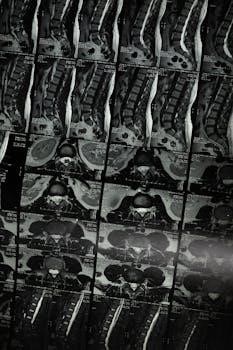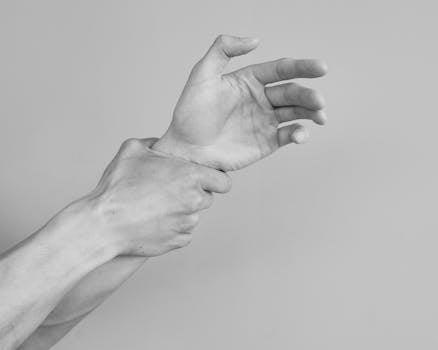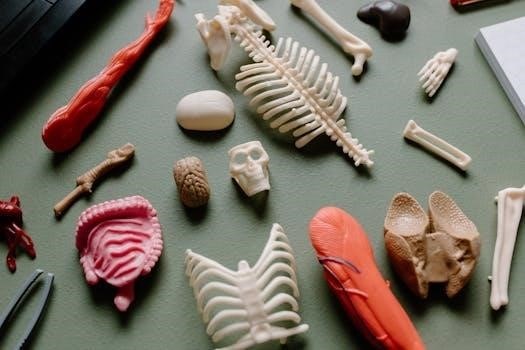The 13th Edition of the Human Anatomy & Physiology Laboratory Manual is a widely used resource. It helps students learn about the human body’s structure and function. The manual contains various experiments and exercises designed for healthcare programs, promoting a deeper understanding of A&P.
Overview of the Lab Manual
The Human Anatomy & Physiology Laboratory Manual, 13th Edition, serves as a vital component for students engaged in introductory A&P courses. This manual offers a wide array of experiments and activities designed to solidify understanding of complex anatomical structures and physiological processes. It caters particularly to students pursuing careers in healthcare, providing hands-on experiences that bridge theoretical knowledge with practical application.
The lab manual is structured to guide students through a comprehensive exploration of the human body. From basic cellular functions to intricate organ systems, each exercise builds upon previous concepts, fostering a holistic understanding. The manual’s design facilitates both in-class learning and independent study, promoting student engagement and critical thinking.

Furthermore, the 13th Edition emphasizes clarity and accessibility. The content is presented in a user-friendly manner, ensuring that students of varying backgrounds can effectively grasp key concepts. The manual integrates seamlessly with various A&P textbooks, providing a versatile and adaptable learning tool that enhances the overall educational experience.
Key Features of the 13th Edition
The 13th Edition of the Human Anatomy & Physiology Laboratory Manual boasts several enhanced features designed to optimize the learning experience. A prominent addition is the inclusion of numerous full-color figures and photos, providing students with visually engaging representations of anatomical structures. These visuals aid in comprehension and retention, making complex concepts more accessible.
Furthermore, this edition incorporates revamped clinical application and critical thinking questions. These additions encourage students to apply their knowledge to real-world scenarios, fostering problem-solving skills crucial for healthcare professionals. The manual also integrates Practice Anatomy Lab (PAL) 3.1 and animations within pre-lab assignments and lab activities, providing interactive learning opportunities.
Over 50 lab videos are featured, offering comprehensive reviews of key A&P concepts and lab procedures. Screenshots within the manual provide easy reference points for these videos. This multimedia integration caters to diverse learning styles, ensuring that students have access to various resources that support their understanding and mastery of the material. The updated edition prioritizes student engagement and practical application.
Versions Available (Main, Cat, Fetal Pig)
The Human Anatomy & Physiology Laboratory Manual, 13th Edition, is available in three distinct versions to cater to diverse course requirements and learning preferences. The “Main” version offers a comprehensive set of exercises covering a broad spectrum of anatomical and physiological concepts. This version is suitable for courses that do not incorporate dissections or focus solely on human anatomy.
For courses that include animal dissection, the “Cat” version provides tailored exercises that utilize cat specimens. This version allows students to gain hands-on experience with anatomical structures through dissection, enhancing their understanding of comparative anatomy. The “Cat” version includes detailed dissection instructions and relevant anatomical illustrations.
Similarly, the “Fetal Pig” version is designed for courses that utilize fetal pig specimens for dissection. This version offers an alternative to cat dissection, providing students with another opportunity to explore mammalian anatomy. Like the “Cat” version, it includes specific dissection guides and anatomical references to support student learning. Each version ensures relevant content aligned with specific laboratory activities.
Use with Mastering A&P
The Human Anatomy & Physiology Laboratory Manual, 13th Edition, is designed to seamlessly integrate with Mastering A&P, Pearson’s leading online homework and learning platform. Mastering A&P offers a wealth of resources that complement the lab manual, providing students with a comprehensive learning experience both inside and outside the laboratory.

By using Mastering A&P alongside the lab manual, students can access interactive tutorials, quizzes, and assessments that reinforce key concepts and help them master challenging topics. Mastering A&P also includes a variety of multimedia resources, such as animations and videos, that bring anatomy and physiology to life.
Instructors can use Mastering A&P to track student progress, identify areas where students are struggling, and provide personalized feedback. The platform also offers tools for creating and assigning homework, quizzes, and exams. The integration of the lab manual with Mastering A&P enhances student engagement, improves learning outcomes, and streamlines course management, making it a valuable tool for both students and instructors in the A&P laboratory course.
Integration of Lab Videos and Media
The Human Anatomy & Physiology Laboratory Manual, 13th Edition, significantly enhances student learning through the integration of over 50 lab videos, Practice Anatomy Lab (PAL) 3.1, and engaging animations. These resources are strategically featured within pre-lab assignments and lab activities to maximize comprehension of key A&P concepts and lab procedures.
Each lab video and media element is clearly identified within the lab manual using screenshots, ensuring easy reference for students. These visual aids provide step-by-step guidance on complex dissections, physiological experiments, and anatomical identifications, fostering a deeper understanding of the subject matter. The videos and animations allow students to visualize processes that are difficult to grasp through static images or text alone.
Furthermore, the inclusion of PAL 3.1 provides students with virtual dissection experiences and interactive 3D models, allowing them to explore anatomical structures in a dynamic and engaging way. The integration of these diverse media resources transforms the lab experience, making it more accessible, effective, and enjoyable for students of all learning styles. This multi-modal approach ensures that students are well-prepared for lab activities and can confidently apply their knowledge.
Experiments and Exercises
The Human Anatomy & Physiology Laboratory Manual, 13th Edition, features a wide variety of experiments designed to solidify understanding. Each exercise guides students toward a comprehensive grasp of the human body’s structure and function, specifically tailored for those in healthcare programs. The manual includes classic anatomy labs alongside physiological investigations, providing a balanced approach to learning.
The experiments are designed to minimize unpleasant components traditionally found in anatomy and physiology courses, focusing on clear, concise procedures and expected outcomes. Students engage in hands-on activities that reinforce theoretical concepts learned in lectures and textbooks. These activities range from microscopy and histology to dissections and physiological measurements, offering diverse learning experiences.
Moreover, the manual promotes critical thinking by including pre-lab questions, data analysis sections, and post-lab assessments. These elements encourage students to apply their knowledge, interpret results, and draw meaningful conclusions. The experiments are meticulously designed to be manageable within the constraints of a typical lab session, ensuring that students can complete them effectively and efficiently, thereby boosting their confidence and competence in the subject.
Artwork and Textbook Compatibility
The Human Anatomy & Physiology Laboratory Manual, 13th Edition, incorporates artwork from the Marieb/Hoehn “Human Anatomy & Physiology” textbook, ensuring visual consistency and reinforcement of key concepts. This integration allows students to seamlessly transition between the textbook and the lab manual, enhancing their overall learning experience. The high-quality, full-color figures and photos aid in visualizing complex anatomical structures and physiological processes.
While the lab manual aligns closely with the Marieb/Hoehn textbook, it is designed to be compatible with any standard A&P textbook. The experiments and exercises are structured to cover core concepts that are universally taught in introductory anatomy and physiology courses. This flexibility makes the manual a valuable resource for students using various textbooks or different teaching approaches.
The clear and detailed illustrations, combined with concise textual explanations, enable students to grasp the material effectively, regardless of their primary textbook. The manual’s adaptability ensures that instructors can confidently use it to supplement their existing curriculum, providing students with a comprehensive and visually engaging laboratory experience that complements their textbook readings and lectures, fostering a deeper understanding.

Emphasis on Clinical Applications and Critical Thinking
The 13th Edition of the Human Anatomy & Physiology Laboratory Manual places a strong emphasis on clinical applications and critical thinking skills. The manual integrates real-world scenarios and case studies into the exercises, prompting students to apply their knowledge of anatomy and physiology to solve practical problems encountered in healthcare settings; This approach bridges the gap between theoretical concepts and clinical practice.
Each experiment and exercise includes revamped clinical application questions designed to challenge students to think critically about the implications of their findings. These questions encourage students to analyze data, interpret results, and draw conclusions based on evidence. By engaging with these clinical applications, students develop the skills necessary to make informed decisions in their future healthcare careers.
The manual fosters problem-solving abilities by presenting complex scenarios that require students to integrate information from multiple sources. The goal is to move beyond rote memorization and promote a deeper understanding of how anatomical structures and physiological processes relate to human health and disease. This focus on critical thinking prepares students to be effective and adaptable healthcare professionals who can apply their knowledge to diverse and evolving clinical situations, thus enhancing their preparedness.

Availability and Where to Find It
The Human Anatomy & Physiology Laboratory Manual, 13th Edition, is widely available through various channels. Students can purchase new or used copies from major online retailers like Amazon and CampusBooks.com. Renting options are also often available, providing a more affordable alternative for students. Additionally, many college bookstores carry the manual, ensuring easy access for students enrolled in A&P courses.
Different versions of the manual, including the Main, Cat, and Fetal Pig versions, can be found depending on the specific needs of the course; Digital versions of the manual, often in PDF format, may be available through online platforms or directly from the publisher. Some institutions provide access to the manual through their online learning management systems.
When searching for the manual, it’s crucial to specify the 13th edition and the desired version (Main, Cat, or Fetal Pig) to ensure you obtain the correct resource. ISBN numbers can be used to verify the specific edition and version. Consult your course syllabus or instructor for the precise version required for your A&P laboratory course. Prices and availability may vary, so comparing options is recommended to find the best deal, thus facilitating easy acquisition.
